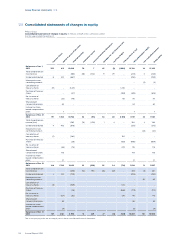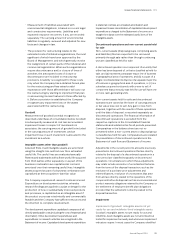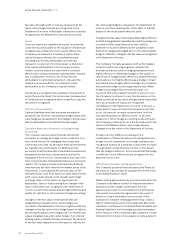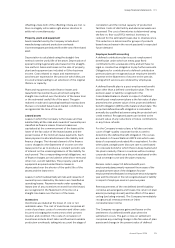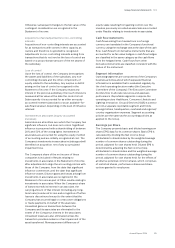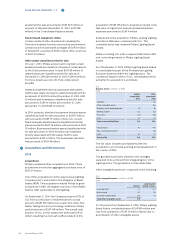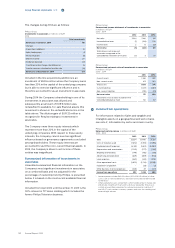Philips 2014 Annual Report Download - page 122
Download and view the complete annual report
Please find page 122 of the 2014 Philips annual report below. You can navigate through the pages in the report by either clicking on the pages listed below, or by using the keyword search tool below to find specific information within the annual report.Group nancial statements 12.9
122 Annual Report 2014
fair value through prot or loss are measured at fair
value, and changes therein are recognized in the
Statement of income. Attributable transaction costs are
recognized in the Statement of income as incurred.
Equity
Common shares are classied as equity. Incremental
costs directly attributable to the issuance of shares are
recognized as a deduction from equity. Where the
Company purchases the Company’s equity share
capital (treasury shares), the consideration paid,
including any directly attributable incremental
transaction costs (net of income taxes), is deducted
from equity attributable to the Company’s equity
holders until the shares are cancelled or reissued.
Where such ordinary shares are subsequently reissued,
any consideration received, net of any directly
attributable incremental transaction costs and the
related income tax eects, is included in equity
attributable to the Company’s equity holders.
Dividends are recognized as a liability in the period in
which they are declared. The income tax consequences
of dividends are recognized when a liability to pay the
dividend is recognized.
Debt and other liabilities
Debt and liabilities other than provisions are stated at
amortized cost. However, loans that are hedged under a fair
value hedge are remeasured for the changes in the fair value
that are attributable to the risk that is being hedged.
Derivative nancial instruments, including hedge
accounting
The Company uses derivative nancial instruments
principally to manage its foreign currency risks and, to a
more limited extent, for managing interest rate and
commodity price risks. All derivative nancial instruments
are classied as current assets or liabilities and are
accounted for at the trade date. Embedded derivatives are
separated from the host contract and accounted for
separately if the economic characteristics and risks of the
host contract and the embedded derivative are not closely
related. The Company measures all derivative nancial
instruments at fair value derived from market prices of the
instruments, or calculated as the present value of the
estimated future cash ows based on observable interest
yield curves, basis spread, credit spreads and foreign
exchange rates, or from option pricing models, as
appropriate. Gains or losses arising from changes in fair
value of derivatives are recognized in the Statement of
income, except for derivatives that are highly eective and
qualify for cash ow or net investment hedge accounting.
Changes in the fair value of derivatives that are
designated and qualify as fair value hedges are
recorded in the Statement of income, together with any
changes in the fair value of the hedged asset or liability
that are attributable to the hedged risk. For interest rate
swaps designated as a fair value hedge of an interest
bearing asset or liability that are unwound, the amount
of the fair value adjustment to the asset or liability for
the risk being hedged is released to the Statement of
income over the remaining life of the asset or liability
based on the recalculated eective yield.
Changes in the fair value of a derivative that is highly effective
and that is designated and qualifies as a cash flow hedge, are
recorded in Other comprehensive income, until the
Statement of income is affected by the variability in cash
flows of the designated hedged item. To the extent that the
hedge is ineffective, changes in the fair value are recognized
in the Statement of income.
The Company formally assesses, both at the hedge’s
inception and on an ongoing basis, whether the
derivatives that are used in hedging transactions are
highly eective in osetting changes in fair values or
cash ows of hedged items. When it is established that
a derivative is not highly eective as a hedge or that it
has ceased to be a highly eective hedge, the Company
discontinues hedge accounting prospectively. When
hedge accounting is discontinued because it is
expected that a forecasted transaction will not occur,
the Company continues to carry the derivative on the
Balance sheet at its fair value, and gains and losses that
were accumulated in equity are recognized
immediately in the Statement of income. If there is a
delay and it is expected that the transaction will still
occur, the amount in equity remains there until the
forecasted transaction aects income. In all other
situations in which hedge accounting is discontinued,
the Company continues to carry the derivative at its fair
value on the Balance sheet, and recognizes any
changes in its fair value in the Statement of income.
Foreign currency dierences arising on the
retranslation of nancial instruments designated as a
hedge of a net investment in a foreign operation are
recognized directly as a separate component of equity
through Other comprehensive income, to the extent
that the hedge is eective. To the extent that the hedge
is ineective, such dierences are recognized in the
Statement of income.
Osetting and master netting agreements
The Company presents nancial assets and nancial
liabilities on a gross basis as separate line items in the
Consolidated balance sheet.
Master netting agreements may be entered into when the
Company undertakes a number of nancial instrument
transactions with a single counterparty. Such an
agreement provides for a net settlement of all nancial
instruments covered by the agreement in the event of
default or certain termination events on any of the
transactions. A master netting agreement may create a
right of oset that becomes enforceable and aects the
realization or settlement of individual nancial assets and
nancial liabilities only following a specied termination
event. However, if this contractual right is subject to certain
limitations then it does not necessarily provide a basis for




